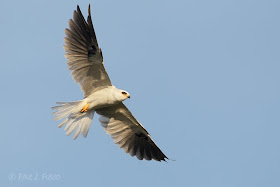The White-tailed Kite is still here! However, there has been no sign of the Brown Pelican since the evening of August 10. A Black Tern, possibly the same bird, was seen today at Milford Point. This is the nature of pelican sightings in Connecticut, especially Brown. They are often seen and never relocated. The fact we saw the pelican land in water in Milford and a few people were actually able to get to Stratford or Milford to scope it to see it fishing or flying was amazing. Not being able to find it yesterday did not surprise me. Many of Connecticut's well-known names with decades of experience in conservation and birding have never seen a Brown Pelican in the state, including our own Senior Director of Science and Conservation, Milan Bull. My point is that while the bird is rare, the toughest part of seeing one is the fact only those lucky to be wherever one is get a fleeting glimpse. No one else can usually "chase" it. He was certainly envious of me and everyone who was there Tuesday night, to say the very least.
Here is a second high definition video of the White-tailed Kite shot last night, August 11.White-tailed Kite 2 from Connecticut Audubon Society.
The kite was at its favored hunting grounds and the closest thing it has to a home, Stratford Point. The beginning of the video shows it hover-hunting and soaring a bit, which can be tough to see, let alone shoot. Notice some Common Terns and Barn Swallows attacking or pestering it. Towards the end I left in three kind of tough shots of it diving for prey. It is a very fast, agile, and stealthy bird when it wants to be.
Here are a few photos of the kite with a vole, first from the Director of the Coastal Center at Milford Point, Frank Gallo:


A couple more soaring shots from Paul Fusco:
 Thanks to them! Let's hope the White-tailed Kite keeps finding plenty of food. The next week should not feature any major cold fronts, the prominent trigger to fall raptor movements, and the most likely way I believe it would depart. It seems like it will be here for a while longer. If you have not come to see it stop by Stratford Point or Milford Point soon!Photos 1-3 © Frank Gallo; photos 4-5 © Paul Fusco
Thanks to them! Let's hope the White-tailed Kite keeps finding plenty of food. The next week should not feature any major cold fronts, the prominent trigger to fall raptor movements, and the most likely way I believe it would depart. It seems like it will be here for a while longer. If you have not come to see it stop by Stratford Point or Milford Point soon!Photos 1-3 © Frank Gallo; photos 4-5 © Paul Fusco

























+NICE.jpg)




























